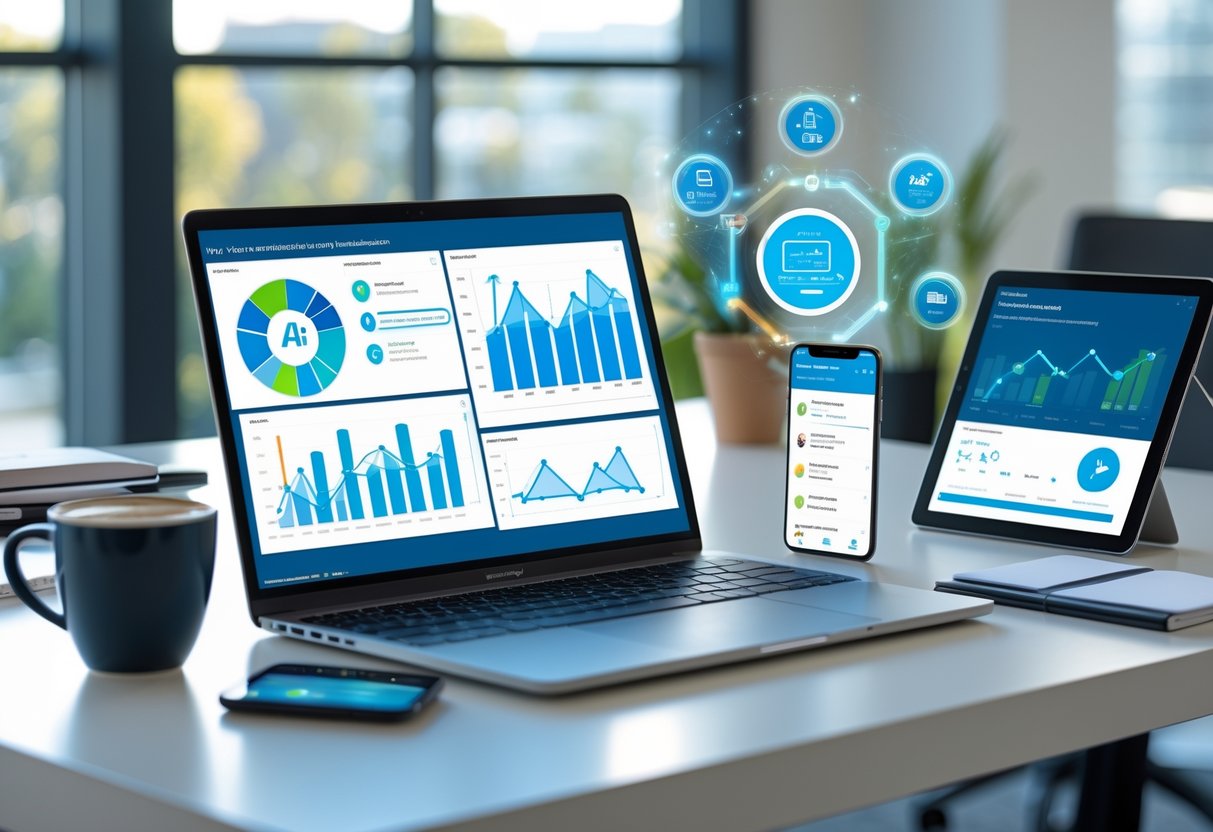When someone reaches out with a question or request, every minute counts. Delayed responses can mean missed opportunities and lost trust.
Inquiry follow-up automation makes sure every message gets a timely, consistent, and personalized reply—without you having to do all the manual work.

I use automation to capture inquiries, organize them, and send thoughtful responses that actually sound human. By doing this, I save myself time and avoid silly mistakes, all while keeping communication clear.
Tools like AI-driven workflows track interactions and adapt messages based on customer history. That way, each follow-up feels more relevant and less robotic.
With the right setup, I can focus on building real relationships instead of juggling repetitive tasks all day. Automation doesn’t replace genuine connection—it just makes sure no inquiry slips through the cracks.
If you’re tired of chasing leads and want to make life easier, honestly, feel free to contact me on Whatsapp at +917303556188 for a chat, consultation, or to buy high-quality leads. Why struggle when you can let me handle it?
Key Takeaways
- Automation means fast, consistent replies.
- Smart tools personalize and track every follow-up.
- Streamlined workflows save time and build trust.
What Is Inquiry Follow-Up Automation?
I use inquiry follow-up automation to handle customer questions and requests quickly and consistently. It tracks communication, cuts delays, and keeps potential clients engaged, so I’m not glued to my inbox every minute.
Definition and Core Concepts
Inquiry follow-up automation uses software tools that automatically respond to or manage customer inquiries. These systems notice when a new message, form submission, or request comes in, then trigger actions like sending an email, updating records, or creating a task.
To me, it’s about having a real process instead of relying on memory or sticky notes. I set rules so every inquiry gets attention.
For example, when a lead fills out a form, the system can shoot them a welcome email and remind me to follow up. It’s simple but powerful.
The main ideas? Automation triggers (events that start things), actions (emails, reminders, updates), and workflows (the steps). Put together, these let me handle inquiries at scale without sounding like a robot.
Importance for Businesses
When I try to manage leads manually, I end up missing messages or replying too late. That’s a recipe for losing customers to competitors.
With follow-up automation, I make sure no inquiry gets ignored. Timely responses often mean the difference between winning a customer and losing them.
Businesses benefit from faster replies, consistent communication, and better tracking. Tools like Follow Up Boss help me assign tasks, set reminders, and keep everything organized.
Instead of writing the same reply over and over, I use templates and triggers. That frees me up for calls or meetings, while routine inquiries get answered automatically.
Trust me, if you want to skip the hassle, just reach out to me on Whatsapp at +917303556188. I’ll get you sorted with leads or a system that works.
Types of Customer Inquiries
Not all inquiries are the same, so I handle them differently. Usually, I see three main types:
- Sales inquiries: Questions about pricing, products, or services.
- Support inquiries: Requests for help, troubleshooting, or guidance.
- General inquiries: Basic questions, feedback, or non-urgent stuff.
Automation can sort these and route them to the right place. AI-driven systems analyze the text, tag it, and assign it to the right workflow.
A sales inquiry might trigger a follow-up email sequence. A support request could open a ticket.
By organizing inquiries this way, I make sure each one gets the right response. It keeps things smooth and cuts down on confusion.
Key Benefits of Automating Inquiry Follow-Ups

When I automate inquiry follow-ups, I cut out repetitive work, reach customers faster, and make communication way more consistent. It’s a win for saving time, winning new business, and keeping customers happy.
Saving Time and Reducing Manual Effort
Manual follow-ups are a pain. I used to send the same reminders, check calendars, and track responses by hand.
Automating these steps frees me from boring, repetitive tasks. Now I can focus on things that actually matter.
With tools that handle scheduling and reminders, I don’t worry about missed messages. AI inquiry agents send timely updates via email, SMS, or chat without me lifting a finger.
Automation also wipes out silly errors. When I tracked everything by hand, I’d forget a lead or send the wrong info. Automated systems follow the rules, so nothing slips through.
Boosting Conversion Rates
Follow-ups turn inquiries into paying customers. Most sales need several points of contact, but honestly, who has time to do that manually?
Automated follow-ups make sure no lead goes cold. With behavior-based triggers, I send messages that actually fit what the customer’s doing.
CRM automation delivers a response when someone opens an email or clicks on a link. That makes outreach timely and relevant.
When prospects see fast, regular replies, they stick around. Consistency builds trust and boosts my conversion rates—without any extra effort.
Improving Customer Satisfaction
Customers want quick, clear replies. If I’m slow, I risk losing their interest.
Automated follow-ups help me hit those expectations by sending updates right after an inquiry. With personalization tools, I send messages that feel tailored, not canned.
AI-powered follow-up systems even adjust tone and content based on customer history. It makes the whole exchange feel more thoughtful.
Plus, automation means I’m available 24/7. Even if I’m asleep, customers still get responses or confirmations. That’s a big boost for satisfaction.
If you want to make your life easier—or just want leads without all the work—drop me a Whatsapp at +917303556188. Let me handle the hard part.
Essential Tools and Technologies for Inquiry Follow-Up Automation

I use a mix of AI-driven systems, email automation, and collaboration tools to make follow-ups smoother. These tech tools help me respond faster, personalize messages, and keep the team in sync—without adding more work.
AI-Powered Tools and Chatbots
AI-powered tools and chatbots let me automate routine customer interactions without sounding like a bot. They answer common questions, schedule follow-ups, and gather feedback.
For example, AI agents for service inquiry follow-up use natural language processing to pick up on customer sentiment. That helps me spot when something needs a human touch.
AI-driven classification sorts and prioritizes requests, so I don’t have to dig through every message. It keeps response times fast and makes sure nothing gets missed.
By mixing chatbots with real people, I handle more support without losing quality. Bots do the repetitive stuff; my team jumps in for the tough cases.
Email Automation Platforms
Email automation platforms keep my communication timely and consistent. I set up workflows that send follow-ups based on what the customer does—like filling out a form or leaving a cart behind.
Automated follow-up email systems let me personalize messages with customer data. That way, the outreach feels relevant, not spammy.
Most platforms also give me analytics—open rates, clicks, replies—so I can tweak my approach. Some even sync with CRMs, so I see all customer interactions in one spot.
That keeps my communication tidy and aligned with the team.
Integration with Slack and Other Collaboration Tools
I link up my inquiry follow-up automation with Slack to keep the team in the loop instantly. Instead of just email alerts, I get real-time notifications when a customer responds or something needs urgent attention.
I can assign tasks right in Slack, cutting down on delays. Urgent inquiries pop up where the team actually hangs out.
Collaboration tools also give us shared dashboards and reporting. I track follow-up completion rates and customer satisfaction scores without leaving Slack.
By connecting AI, email automation, and Slack, I build a workflow that’s actually streamlined. No more dropped balls.
Designing Effective Automated Follow-Up Workflows

I build workflows that react to clear triggers, use natural timing, and reach people where they actually hang out. This keeps follow-ups relevant and makes life easier for support teams.
Identifying Triggers and Conditions
I start by setting the exact events that should trigger a follow-up—like a new inquiry, a completed purchase, or a missed reply. Each condition links directly to an action so the workflow stays tight.
If someone fills out a contact form, the system sends an acknowledgment email right away. If they click a link but don’t respond, a reminder goes out a couple days later.
I add rules to avoid spamming people. For example, “stop sending if the recipient replies” keeps things professional and efficient.
Personalization and Message Timing
Every follow-up email gets some personalization. Sometimes it’s just their name; other times, I reference their last question or purchase.
Timing matters. I don’t send a bunch of emails at once—that’s annoying. Instead, I space things out:
- Day 0: Acknowledgment email
- Day 2-3: Helpful resource or reminder
- Day 7+: Final prompt or escalation
Tools like email follow-up automation platforms help me schedule these steps so they match user behavior. That keeps my messages timely without me babysitting the system.
Multi-Channel Communication Strategies
I don’t just use email. Some inquiries work better through SMS, chat, or even direct CRM notifications for the support team.
A multi-channel approach means the recipient actually sees the message. For example, I might send an email first, follow up on LinkedIn, and finish with a phone reminder.
Platforms that support multi-channel follow-up automation connect email, chat apps, and CRMs in one place.
When all responses get logged in the same system, the team sees the full history. That way, everyone stays on the same page and no one doubles up on outreach.
Measuring and Optimizing Inquiry Follow-Up Automation
I focus on real results when I improve inquiry follow-up automation. I track engagement, test new ideas, and listen to customer feedback so my workflows actually get faster responses and better experiences.
If you’re ready to stop chasing leads and want to make your business run smoother, feel free to contact me on Whatsapp at +917303556188 for a consultation or to buy leads. Why work harder when you can just let me handle it?
Tracking Response Rates and Engagement
I keep an eye on response rates, open rates, and click-throughs. These numbers tell me if my automated replies actually reach people at the right moment.
If I see a high open rate but few replies, that usually means my subject lines are good, but maybe the content needs a tweak.
To keep things organized, I use dashboards that break everything down:
| Metric | What It Shows | Why It Matters |
|---|---|---|
| Open Rate | Email visibility and subject appeal | Gauges first impression |
| Response Rate | Customer willingness to engage | Key measure of automation value |
| Click-Through Rate | Interest in links or CTAs | Reveals message relevance |
I always track follow-up timing too. If most replies come in within 24 hours, I know my delays work.
If engagement drops, I’ll play around with the intervals—shorten or extend them until they match how people actually behave.
Honestly, why stress over all this yourself? If you want solid leads and less hassle, just reach out to me on Whatsapp at +917303556188. Feel free to contact anytime for consultation or to buy leads. I’m here to make this easy for you.
A/B Testing and Continuous Improvement
I use A/B testing to fine-tune my follow-up automation. For example, I’ll test a short plain-text message against a longer, more designed one.
I only test one thing at a time—maybe the subject line, the email’s tone, CTA placement, or how long I wait between follow-ups.
Once I have enough results, I pick whatever works best and make that my new default. Then I set up a fresh test.
I’m always tweaking, because what worked last month might not work now.
Analyzing Customer Feedback
Metrics are helpful, but I also want to know how people actually feel about my follow-ups. I check out quick surveys, rating forms, or even direct replies.
I ask structured questions to measure satisfaction, plus open-ended ones to get the real story. If people say I’m emailing too much, I dial it back. If they want clearer answers, I update my templates.
Feedback can show me things numbers never will. Ever had a great response rate but the replies are annoyed? That’s why I mix analytics with what people actually say.
Want to skip the trial and error? Seriously, just message me on Whatsapp: +917303556188. Why work harder than you need to? I’ve already figured out what works. Let’s get you those leads.
Frequently Asked Questions
Automation helps me avoid missed opportunities and keeps my responses fast and consistent. I pick the right timing, tools, and add a touch of personalization so follow-ups don’t feel robotic.
What are effective strategies for automating follow-up emails?
I build clear sequences that match where the customer’s at. I set reminders to go out after a few days of no reply. AI-driven personalization keeps messages from feeling stale.
How can I set up a system to efficiently track inquiry follow-ups?
I hook my email automation tool up to a CRM, so every interaction is in one spot. I use a centralized inbox—like the “unibox” in Smartlead—so I never miss a response. Tags and categories help me sort leads fast.
What are the best practices for timing automated follow-up communications?
I don’t send too many emails too quickly. Usually, I’ll send the first follow-up after 2–3 days, then space them out more after that. Testing different gaps helps me find what clicks with my audience.
How do I personalize automated follow-up messages to maintain customer engagement?
I pull in details from the customer’s original inquiry so every message feels tailored. AI tools let me reference real customer data, which keeps things from sounding cookie-cutter. Check out AI-powered follow ups for more on this. Personalization makes all the difference.
What tools are recommended for managing automated follow-up processes?
I use platforms like Zapier to connect apps and set up automatic follow-ups. For email campaigns, Smartlead and Mailmodo handle sequencing, personalization, and tracking. These tools save me hours every week.
Ready to make your life easier? Don’t waste time—just WhatsApp me at +917303556188 if you want to buy leads or need advice. I’m always happy to help, and honestly, it’s way simpler than doing it all yourself.
How can I measure the success of my automated follow-up efforts?
I usually keep an eye on things like open rates, reply rates, and conversions. It’s not rocket science, but these numbers tell me a lot.
I also watch how many folks actually move forward after I send a follow-up. Tools like Smartlead come in handy—they show me which campaigns are working and which ones need a little tweak.
Honestly, if you want to skip the hassle and just get real results, why not let me handle it? Feel free to contact me on WhatsApp at +917303556188 if you need consultation or want to buy leads. Save yourself the headache—sometimes it’s just smarter to let someone else do the heavy lifting.



